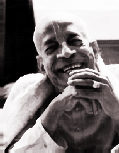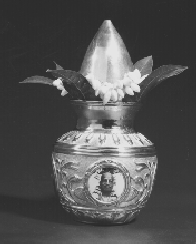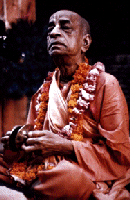


The very first water collection began at the Kumbha Mela in Allahabad in the second week of January of 1995. Hare Krishna devotees then travelled to Gangottari (the source of the Ganges river in the Himalayas), to the Narayani and Kali Gandaki rivers in Nepal, to Mana Sarovara on Mount Kailash, China, and to Vaisnava tirthas in Bangladesh and Bengal. The holy waters of the Yamuna and Sarasvati rivers were gathered along with waters from hundreds of very ancient sacred places throughout South India. Devotees travelled to Rajasthan, Uttar Pradesh, West Bengal and the North Eastern Stares of India with many memorable experiences.
In Northeastern India, which is the furthest remote part of India, the inhabitants are mainly tribal people, aborigines and refugees coming from China, Burma, and Bangladesh. Since these states want to be independent of India, this part of the country is kept in isolation, which makes it difficult to reach. Trains are not available, flights are only once a week and lines of communication are seldom good. The North Eastern States comprise seven sister states, namely Tripura, Manipur, Assam, Meghalaya, Mizoram, Nagaland and Arunachal Pradesh.
Assam
It took Nitai dasa (one of the volunteer water collectors) two days by train from Delhi to reach Guwahati. Without any assistance, he collected water from fourteen different holy places in Assam. In Guwahati, he collected waater from Brahmaputra Nadi, a vast, fast-flowing and cold river that originates from Kailash Manasarovara in Tibet and from Vasistha Falls where Vasistha Muni, the guru of Lord Ramacandra (ref. Ramayana), did penance. From Guwahati, It took one day by bus to reach Silachar. The devotees there were extremely helpful and provided him with a vehicle, a guide, and other amenities to facilitate sacred water collection. With their help, Nitai collected water from Pandava Ghat, where the Pandavas (ref. Mahabharat) had bathed while on exile.
Tripura
Before leaving for Tripura, Nitai was warned to be wary because there were "many uneducated, rash and poor refugees" in the area. He had to take a train, then a bus and finally a truck to Agartala. At this point he had to continue his journey in a convoy with an escort service. He did not understnd what this meant nor what he should expect.
After 3 hours drive, the truck convoy stopped and waited for 12 hours for the next convoy. All the vehicles had to be escorted by the military. The Indian army's presence was overwhelming, with their show of machine guns, tanks and jeeps. All the vehicles had to travel together flanked front and rear by jeeps. The convoy started out from Manu (Tripura) and travelled for 250 kms until 40 or 50 km before Agartala. They travelled through thick jungle set in a lush valley. Although the roads were very rugged, they had to travel extremely fast and could not stop because many trucks carrying goods to Tripura get looted. While driving through the valley, they could see the military personnel perched atop the hills.
The water collection required Nitai dasa to travel to the furthest tip of Tripura, Tirthamukh, which is mainly jungle area inhabited by tribals. Once there he thought, "I will be able to stay at a dharmasala (simple hotel), but all I can see is small mud and grass huts". Finding no shelter for the night, Nitai stood at the entrance of one hut and said, "Hare Krishna, Namaste." When the door opened, he was amazed to see that the entire family were wearing tulasi bead necklaces, tilak on their forehead and they were all Vaishnava devotees! He was totally surprised, because being a predominantly Christian state, it was very rare to find devotees of Krishna in this isolated jungle of Tripura. They embraced Nitai and touched his feet out of respect, then they fed him a big feast and gave him their own room to take rest. Although he had difficulty communicating with them, they were very eager to assist in the sacred water collection. With their help, he collected water from the Gomati Nadi, a river so calm it seemed untouched by human civilization.
Manipur
There were no trains to Manipur so travel had to be by bus with military escort again. The bus had to pass several checkposts which were looking for guns or drugs. At one checkpoint, everyone was ordered off the bus and told to line up against the wall. The sound of rifles being cocked echoed through the air. Everyone was terrified and afraid of bieng shot to death. Nitai had his legs kicked apart and the soldier did a body search. Nitai had to bring down all his trunks with bottles of sacred waters and open them. The soldier saw the empty bottles and maps so he interogated him. With a loaded gun pointed at his head Nitai explained his holy mission to collect water from the sacred river Ganges. This scene was repeated at each of the many inspection points along the route of 220 kms (this took 22 hours to complete).
Finally after reaching Imphal ISKCON, Sanak Kumara dasa and the devotees there offered all assistance in locating and collecting waters from the various tirthas(holy places) in Manipur. Of the nine holy tirthas were water was collected, one was Arjuna kunda, where Arjuna (ref. Bhagavad Gita and Mahabharata) shot his bow and arrow in the ground to draw the seven holy rivers.
Nagaland (literally the land of the snakes)
This is a fully tribal state which practices voodoo, witchcraft, and human sacrifice. The tribal people are naked and eat almost anything, like dogs and cats, which they are able to capture with the most primitive of weapons. It was very difficult to find food here, so Nitai dasa had to live off fruit and biscuits. Travel to Nagaland had to be by train because the government placed a tax on using the roads. There was a 11 hour curfew, then six hours later, Nitai found that the train in front of his had had an accident and all the materials it was transporting had fallen on the railroad tracks. This caused a 2 day delay for his train which was stuck in the middle of the jungle with no drinking water.
Finally reaching the destination in Dimapur, he travelled to Hidimba kunda where the marriage of Bhima(ref. Maharharata) and Hidimba took place after killing Hidimba's demon brother. At the home of Hidimba there are still remains of large pillars with archeological significance.
Fortunately, all these bottles of sacred waters reached New Delhi International Centennial office without being spilled or the jars being broken. Nitai dasa recalls, "I identify with these jars of sacred water on a personal level. They go with me wherever I go. I sleep with the trunks and they don't go anywhere out of my sight. There is a lot of tapasya (austerity), pain and hard work involved. Not just anyone can bring these waters back, so I realize that I have been blessed to have this opportunity. Krishna has also given me so much energy. I never realized that I could do so much, despite foregoing a meal, or sometimes working 16 or 17 hour after only 3 hours of sleep. The next day, I am up and have the energy of a young child. I don't know where this comes from, since I hardly eat or sleep. I am just very eager perhaps you might say "hungry" - hungry for collecting these holy waters."
Nitai dasa is a Centennial volunteer from Pondichery, India, certainly a brave, dedicated and rare soul.

